Food Safety Management: Analysis of Practices at Social Eating House
VerifiedAdded on 2023/06/18
|24
|5874
|418
Report
AI Summary
This report provides a comprehensive analysis of food safety management practices at Social Eating House, a deluxe bistro restaurant in London. It examines different food supply chain approaches, including short and long chains, and identifies key stakeholders such as farmers, processors, transporters, and consumers. The report also delves into the principles of effective procurement and sourcing, highlighting the importance of compliance with legislations, accident prevention, consumer satisfaction, and quality requirements. Analytical tools like SWOT and Porter's Five Forces are applied to assess the restaurant's strengths, weaknesses, opportunities, and threats, as well as the competitive intensity within the industry. Furthermore, the report explores the use of product placement as a marketing tool and discusses the management of human capital and resources in operations, property, and resource maintenance. Ethical practices within the organization and their impact on overall business success are also examined, along with recommendations for improving performance through timely delivery, investment in procurement software, and the use of performance review techniques and management tools for monitoring and evaluation.
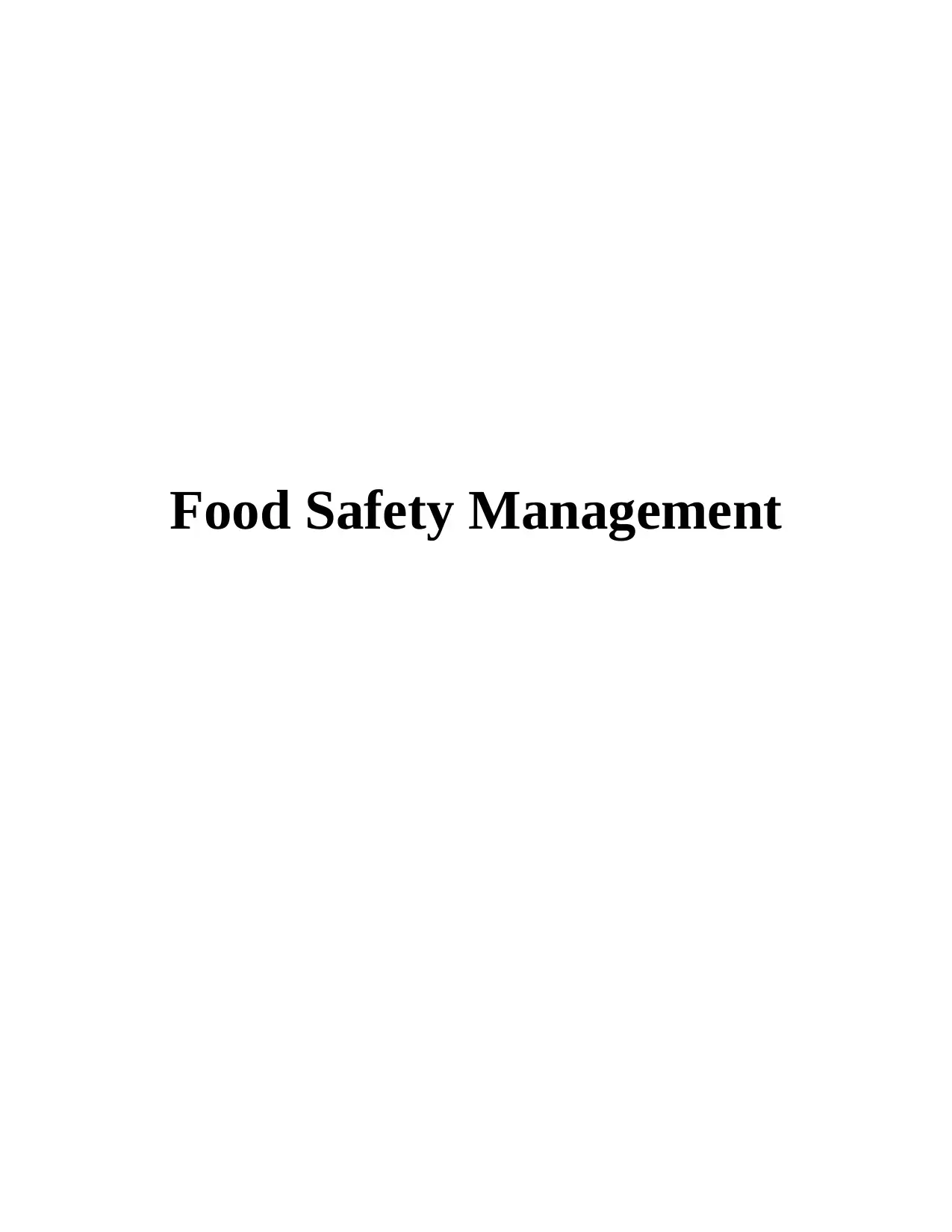
Food Safety Management
Paraphrase This Document
Need a fresh take? Get an instant paraphrase of this document with our AI Paraphraser
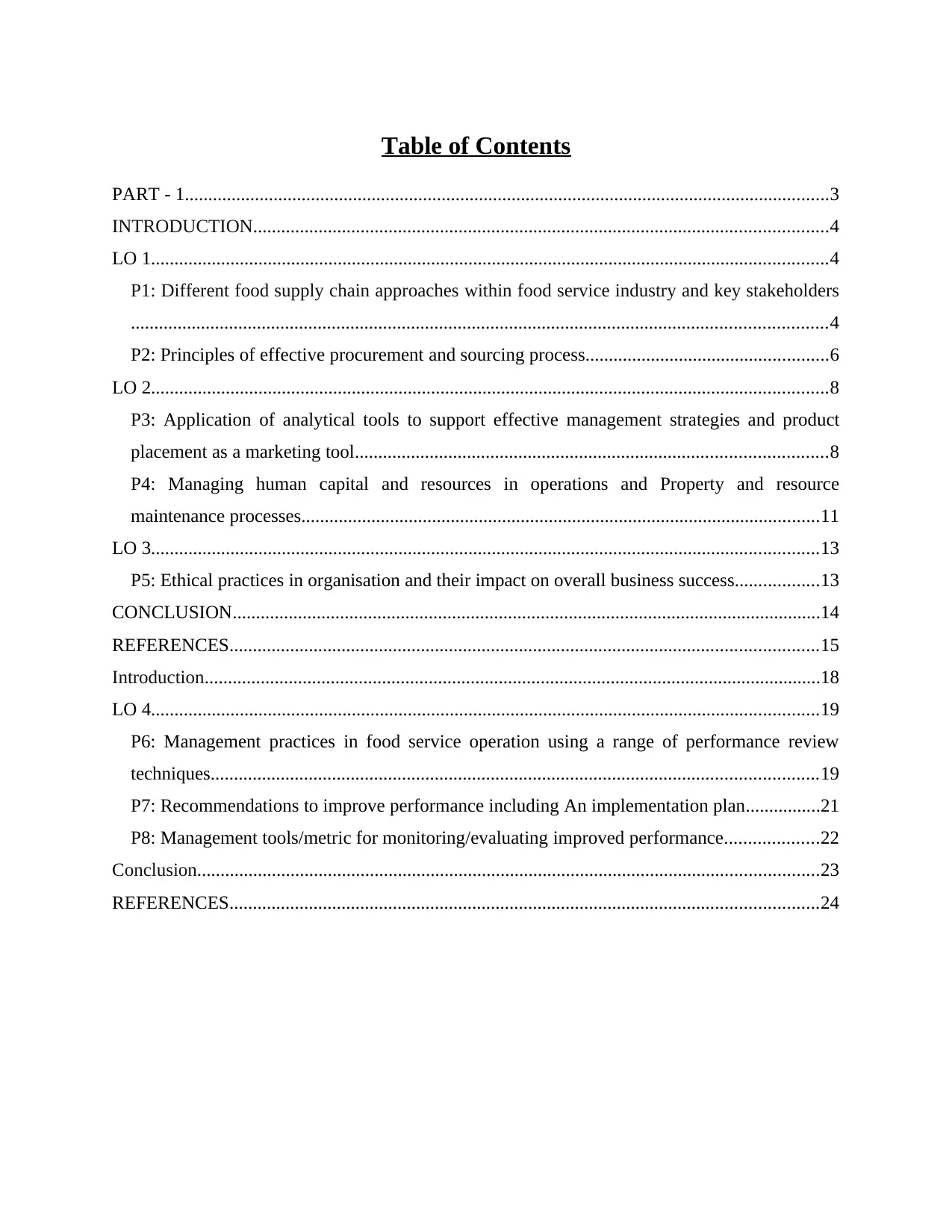
Table of Contents
PART - 1..........................................................................................................................................3
INTRODUCTION...........................................................................................................................4
LO 1.................................................................................................................................................4
P1: Different food supply chain approaches within food service industry and key stakeholders
.....................................................................................................................................................4
P2: Principles of effective procurement and sourcing process....................................................6
LO 2.................................................................................................................................................8
P3: Application of analytical tools to support effective management strategies and product
placement as a marketing tool.....................................................................................................8
P4: Managing human capital and resources in operations and Property and resource
maintenance processes...............................................................................................................11
LO 3...............................................................................................................................................13
P5: Ethical practices in organisation and their impact on overall business success..................13
CONCLUSION..............................................................................................................................14
REFERENCES..............................................................................................................................15
Introduction....................................................................................................................................18
LO 4...............................................................................................................................................19
P6: Management practices in food service operation using a range of performance review
techniques..................................................................................................................................19
P7: Recommendations to improve performance including An implementation plan................21
P8: Management tools/metric for monitoring/evaluating improved performance....................22
Conclusion.....................................................................................................................................23
REFERENCES..............................................................................................................................24
PART - 1..........................................................................................................................................3
INTRODUCTION...........................................................................................................................4
LO 1.................................................................................................................................................4
P1: Different food supply chain approaches within food service industry and key stakeholders
.....................................................................................................................................................4
P2: Principles of effective procurement and sourcing process....................................................6
LO 2.................................................................................................................................................8
P3: Application of analytical tools to support effective management strategies and product
placement as a marketing tool.....................................................................................................8
P4: Managing human capital and resources in operations and Property and resource
maintenance processes...............................................................................................................11
LO 3...............................................................................................................................................13
P5: Ethical practices in organisation and their impact on overall business success..................13
CONCLUSION..............................................................................................................................14
REFERENCES..............................................................................................................................15
Introduction....................................................................................................................................18
LO 4...............................................................................................................................................19
P6: Management practices in food service operation using a range of performance review
techniques..................................................................................................................................19
P7: Recommendations to improve performance including An implementation plan................21
P8: Management tools/metric for monitoring/evaluating improved performance....................22
Conclusion.....................................................................................................................................23
REFERENCES..............................................................................................................................24

PART - 1
⊘ This is a preview!⊘
Do you want full access?
Subscribe today to unlock all pages.

Trusted by 1+ million students worldwide
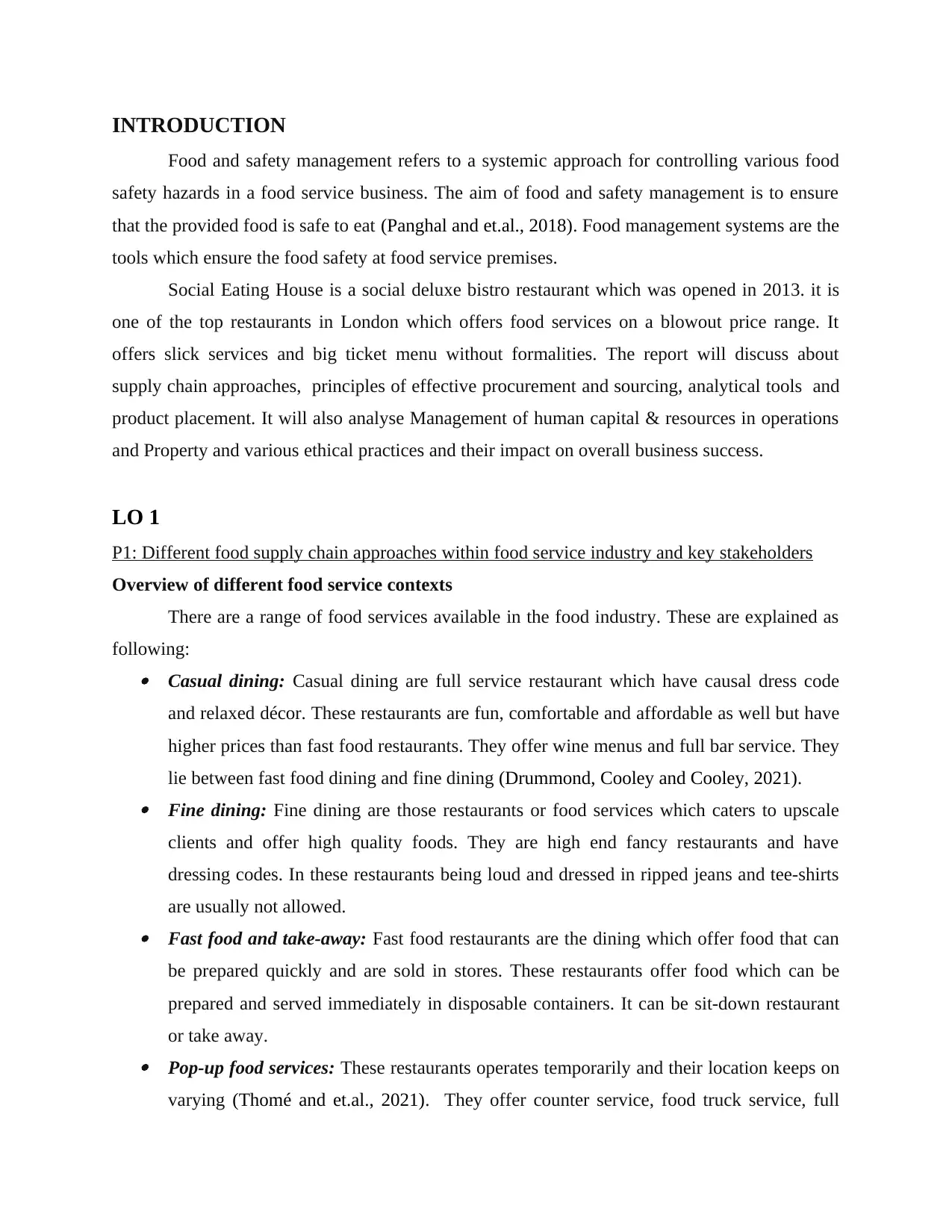
INTRODUCTION
Food and safety management refers to a systemic approach for controlling various food
safety hazards in a food service business. The aim of food and safety management is to ensure
that the provided food is safe to eat (Panghal and et.al., 2018). Food management systems are the
tools which ensure the food safety at food service premises.
Social Eating House is a social deluxe bistro restaurant which was opened in 2013. it is
one of the top restaurants in London which offers food services on a blowout price range. It
offers slick services and big ticket menu without formalities. The report will discuss about
supply chain approaches, principles of effective procurement and sourcing, analytical tools and
product placement. It will also analyse Management of human capital & resources in operations
and Property and various ethical practices and their impact on overall business success.
LO 1
P1: Different food supply chain approaches within food service industry and key stakeholders
Overview of different food service contexts
There are a range of food services available in the food industry. These are explained as
following: Casual dining: Casual dining are full service restaurant which have causal dress code
and relaxed décor. These restaurants are fun, comfortable and affordable as well but have
higher prices than fast food restaurants. They offer wine menus and full bar service. They
lie between fast food dining and fine dining (Drummond, Cooley and Cooley, 2021). Fine dining: Fine dining are those restaurants or food services which caters to upscale
clients and offer high quality foods. They are high end fancy restaurants and have
dressing codes. In these restaurants being loud and dressed in ripped jeans and tee-shirts
are usually not allowed. Fast food and take-away: Fast food restaurants are the dining which offer food that can
be prepared quickly and are sold in stores. These restaurants offer food which can be
prepared and served immediately in disposable containers. It can be sit-down restaurant
or take away. Pop-up food services: These restaurants operates temporarily and their location keeps on
varying (Thomé and et.al., 2021). They offer counter service, food truck service, full
Food and safety management refers to a systemic approach for controlling various food
safety hazards in a food service business. The aim of food and safety management is to ensure
that the provided food is safe to eat (Panghal and et.al., 2018). Food management systems are the
tools which ensure the food safety at food service premises.
Social Eating House is a social deluxe bistro restaurant which was opened in 2013. it is
one of the top restaurants in London which offers food services on a blowout price range. It
offers slick services and big ticket menu without formalities. The report will discuss about
supply chain approaches, principles of effective procurement and sourcing, analytical tools and
product placement. It will also analyse Management of human capital & resources in operations
and Property and various ethical practices and their impact on overall business success.
LO 1
P1: Different food supply chain approaches within food service industry and key stakeholders
Overview of different food service contexts
There are a range of food services available in the food industry. These are explained as
following: Casual dining: Casual dining are full service restaurant which have causal dress code
and relaxed décor. These restaurants are fun, comfortable and affordable as well but have
higher prices than fast food restaurants. They offer wine menus and full bar service. They
lie between fast food dining and fine dining (Drummond, Cooley and Cooley, 2021). Fine dining: Fine dining are those restaurants or food services which caters to upscale
clients and offer high quality foods. They are high end fancy restaurants and have
dressing codes. In these restaurants being loud and dressed in ripped jeans and tee-shirts
are usually not allowed. Fast food and take-away: Fast food restaurants are the dining which offer food that can
be prepared quickly and are sold in stores. These restaurants offer food which can be
prepared and served immediately in disposable containers. It can be sit-down restaurant
or take away. Pop-up food services: These restaurants operates temporarily and their location keeps on
varying (Thomé and et.al., 2021). They offer counter service, food truck service, full
Paraphrase This Document
Need a fresh take? Get an instant paraphrase of this document with our AI Paraphraser
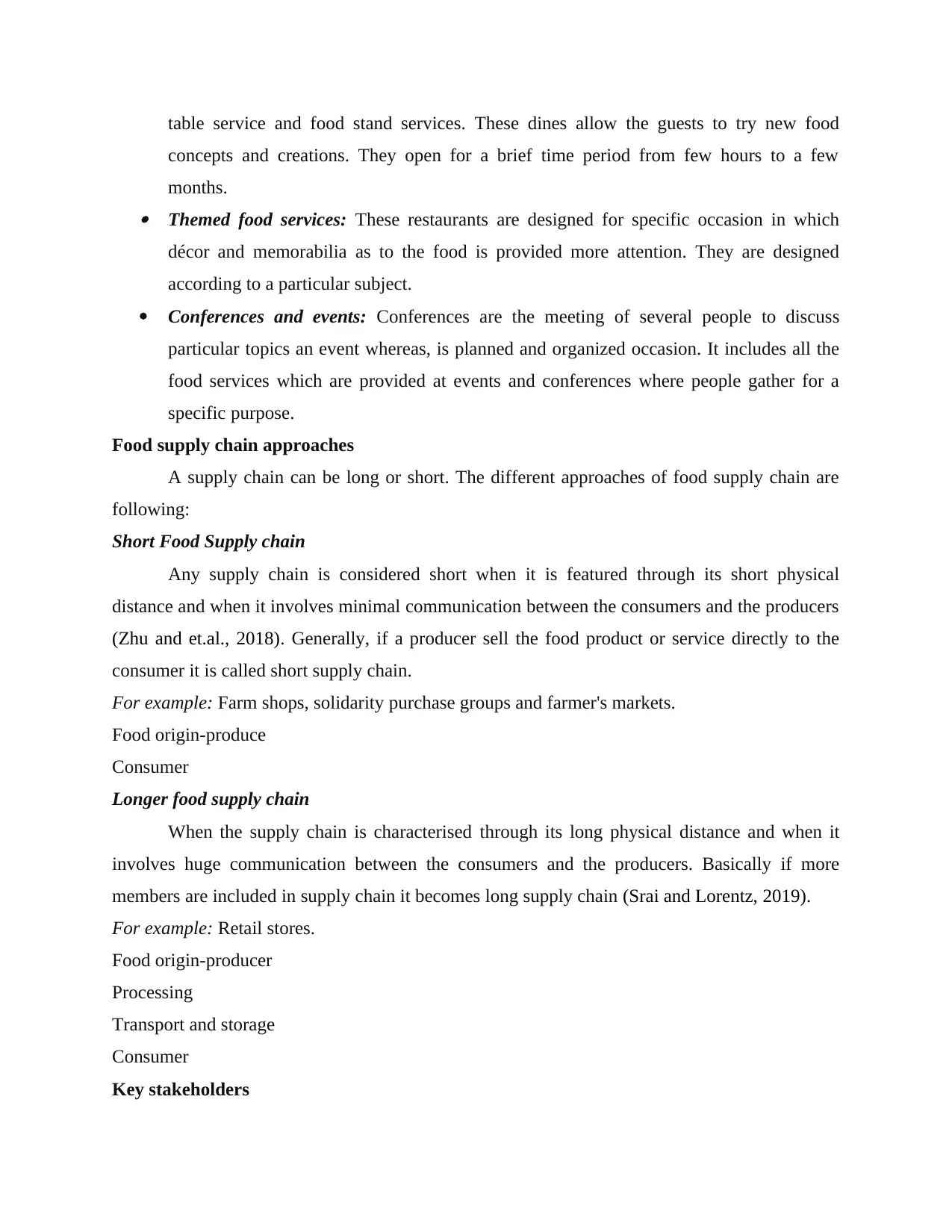
table service and food stand services. These dines allow the guests to try new food
concepts and creations. They open for a brief time period from few hours to a few
months. Themed food services: These restaurants are designed for specific occasion in which
décor and memorabilia as to the food is provided more attention. They are designed
according to a particular subject.
Conferences and events: Conferences are the meeting of several people to discuss
particular topics an event whereas, is planned and organized occasion. It includes all the
food services which are provided at events and conferences where people gather for a
specific purpose.
Food supply chain approaches
A supply chain can be long or short. The different approaches of food supply chain are
following:
Short Food Supply chain
Any supply chain is considered short when it is featured through its short physical
distance and when it involves minimal communication between the consumers and the producers
(Zhu and et.al., 2018). Generally, if a producer sell the food product or service directly to the
consumer it is called short supply chain.
For example: Farm shops, solidarity purchase groups and farmer's markets.
Food origin-produce
Consumer
Longer food supply chain
When the supply chain is characterised through its long physical distance and when it
involves huge communication between the consumers and the producers. Basically if more
members are included in supply chain it becomes long supply chain (Srai and Lorentz, 2019).
For example: Retail stores.
Food origin-producer
Processing
Transport and storage
Consumer
Key stakeholders
concepts and creations. They open for a brief time period from few hours to a few
months. Themed food services: These restaurants are designed for specific occasion in which
décor and memorabilia as to the food is provided more attention. They are designed
according to a particular subject.
Conferences and events: Conferences are the meeting of several people to discuss
particular topics an event whereas, is planned and organized occasion. It includes all the
food services which are provided at events and conferences where people gather for a
specific purpose.
Food supply chain approaches
A supply chain can be long or short. The different approaches of food supply chain are
following:
Short Food Supply chain
Any supply chain is considered short when it is featured through its short physical
distance and when it involves minimal communication between the consumers and the producers
(Zhu and et.al., 2018). Generally, if a producer sell the food product or service directly to the
consumer it is called short supply chain.
For example: Farm shops, solidarity purchase groups and farmer's markets.
Food origin-produce
Consumer
Longer food supply chain
When the supply chain is characterised through its long physical distance and when it
involves huge communication between the consumers and the producers. Basically if more
members are included in supply chain it becomes long supply chain (Srai and Lorentz, 2019).
For example: Retail stores.
Food origin-producer
Processing
Transport and storage
Consumer
Key stakeholders
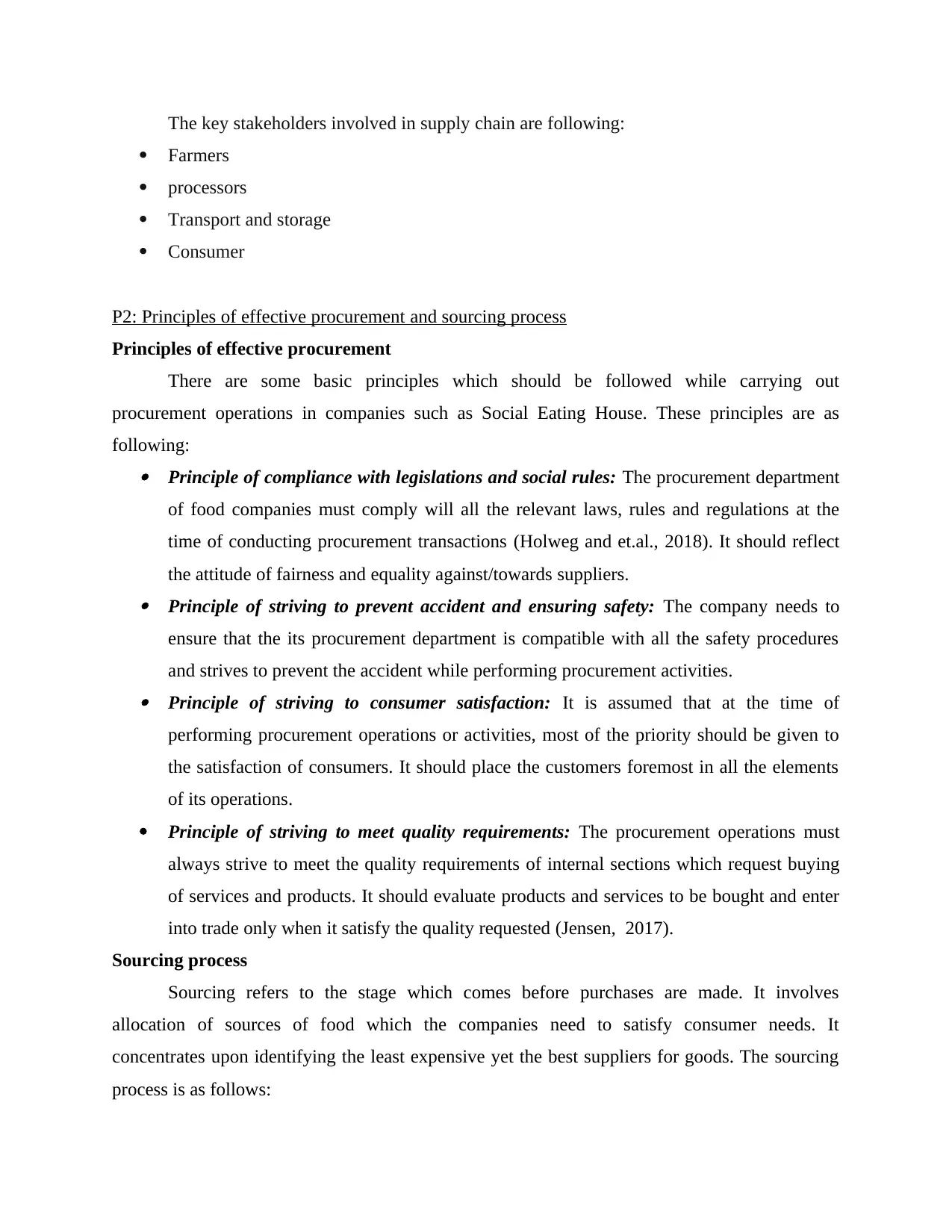
The key stakeholders involved in supply chain are following:
Farmers
processors
Transport and storage
Consumer
P2: Principles of effective procurement and sourcing process
Principles of effective procurement
There are some basic principles which should be followed while carrying out
procurement operations in companies such as Social Eating House. These principles are as
following: Principle of compliance with legislations and social rules: The procurement department
of food companies must comply will all the relevant laws, rules and regulations at the
time of conducting procurement transactions (Holweg and et.al., 2018). It should reflect
the attitude of fairness and equality against/towards suppliers. Principle of striving to prevent accident and ensuring safety: The company needs to
ensure that the its procurement department is compatible with all the safety procedures
and strives to prevent the accident while performing procurement activities. Principle of striving to consumer satisfaction: It is assumed that at the time of
performing procurement operations or activities, most of the priority should be given to
the satisfaction of consumers. It should place the customers foremost in all the elements
of its operations.
Principle of striving to meet quality requirements: The procurement operations must
always strive to meet the quality requirements of internal sections which request buying
of services and products. It should evaluate products and services to be bought and enter
into trade only when it satisfy the quality requested (Jensen, 2017).
Sourcing process
Sourcing refers to the stage which comes before purchases are made. It involves
allocation of sources of food which the companies need to satisfy consumer needs. It
concentrates upon identifying the least expensive yet the best suppliers for goods. The sourcing
process is as follows:
Farmers
processors
Transport and storage
Consumer
P2: Principles of effective procurement and sourcing process
Principles of effective procurement
There are some basic principles which should be followed while carrying out
procurement operations in companies such as Social Eating House. These principles are as
following: Principle of compliance with legislations and social rules: The procurement department
of food companies must comply will all the relevant laws, rules and regulations at the
time of conducting procurement transactions (Holweg and et.al., 2018). It should reflect
the attitude of fairness and equality against/towards suppliers. Principle of striving to prevent accident and ensuring safety: The company needs to
ensure that the its procurement department is compatible with all the safety procedures
and strives to prevent the accident while performing procurement activities. Principle of striving to consumer satisfaction: It is assumed that at the time of
performing procurement operations or activities, most of the priority should be given to
the satisfaction of consumers. It should place the customers foremost in all the elements
of its operations.
Principle of striving to meet quality requirements: The procurement operations must
always strive to meet the quality requirements of internal sections which request buying
of services and products. It should evaluate products and services to be bought and enter
into trade only when it satisfy the quality requested (Jensen, 2017).
Sourcing process
Sourcing refers to the stage which comes before purchases are made. It involves
allocation of sources of food which the companies need to satisfy consumer needs. It
concentrates upon identifying the least expensive yet the best suppliers for goods. The sourcing
process is as follows:
⊘ This is a preview!⊘
Do you want full access?
Subscribe today to unlock all pages.

Trusted by 1+ million students worldwide
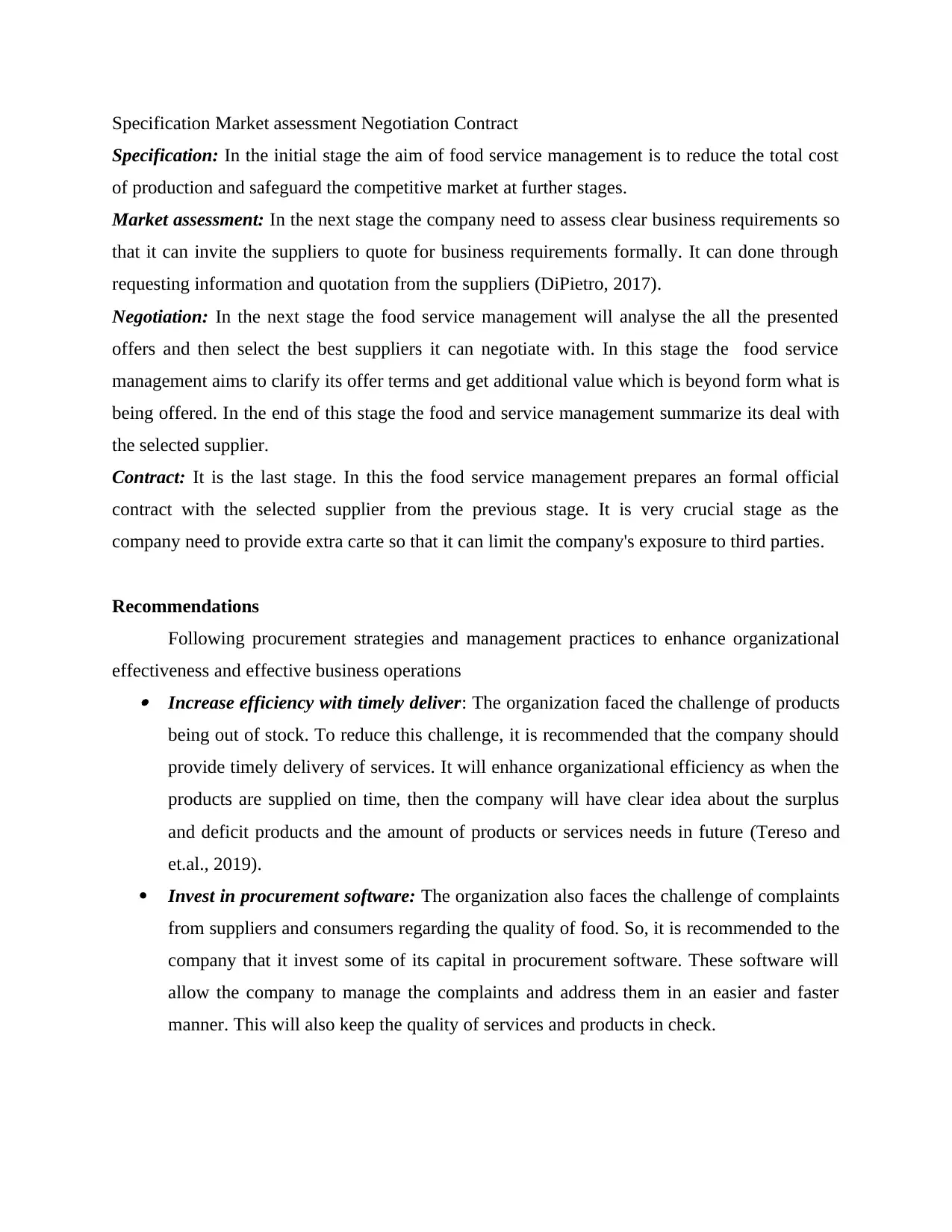
Specification Market assessment Negotiation Contract
Specification: In the initial stage the aim of food service management is to reduce the total cost
of production and safeguard the competitive market at further stages.
Market assessment: In the next stage the company need to assess clear business requirements so
that it can invite the suppliers to quote for business requirements formally. It can done through
requesting information and quotation from the suppliers (DiPietro, 2017).
Negotiation: In the next stage the food service management will analyse the all the presented
offers and then select the best suppliers it can negotiate with. In this stage the food service
management aims to clarify its offer terms and get additional value which is beyond form what is
being offered. In the end of this stage the food and service management summarize its deal with
the selected supplier.
Contract: It is the last stage. In this the food service management prepares an formal official
contract with the selected supplier from the previous stage. It is very crucial stage as the
company need to provide extra carte so that it can limit the company's exposure to third parties.
Recommendations
Following procurement strategies and management practices to enhance organizational
effectiveness and effective business operations Increase efficiency with timely deliver: The organization faced the challenge of products
being out of stock. To reduce this challenge, it is recommended that the company should
provide timely delivery of services. It will enhance organizational efficiency as when the
products are supplied on time, then the company will have clear idea about the surplus
and deficit products and the amount of products or services needs in future (Tereso and
et.al., 2019).
Invest in procurement software: The organization also faces the challenge of complaints
from suppliers and consumers regarding the quality of food. So, it is recommended to the
company that it invest some of its capital in procurement software. These software will
allow the company to manage the complaints and address them in an easier and faster
manner. This will also keep the quality of services and products in check.
Specification: In the initial stage the aim of food service management is to reduce the total cost
of production and safeguard the competitive market at further stages.
Market assessment: In the next stage the company need to assess clear business requirements so
that it can invite the suppliers to quote for business requirements formally. It can done through
requesting information and quotation from the suppliers (DiPietro, 2017).
Negotiation: In the next stage the food service management will analyse the all the presented
offers and then select the best suppliers it can negotiate with. In this stage the food service
management aims to clarify its offer terms and get additional value which is beyond form what is
being offered. In the end of this stage the food and service management summarize its deal with
the selected supplier.
Contract: It is the last stage. In this the food service management prepares an formal official
contract with the selected supplier from the previous stage. It is very crucial stage as the
company need to provide extra carte so that it can limit the company's exposure to third parties.
Recommendations
Following procurement strategies and management practices to enhance organizational
effectiveness and effective business operations Increase efficiency with timely deliver: The organization faced the challenge of products
being out of stock. To reduce this challenge, it is recommended that the company should
provide timely delivery of services. It will enhance organizational efficiency as when the
products are supplied on time, then the company will have clear idea about the surplus
and deficit products and the amount of products or services needs in future (Tereso and
et.al., 2019).
Invest in procurement software: The organization also faces the challenge of complaints
from suppliers and consumers regarding the quality of food. So, it is recommended to the
company that it invest some of its capital in procurement software. These software will
allow the company to manage the complaints and address them in an easier and faster
manner. This will also keep the quality of services and products in check.
Paraphrase This Document
Need a fresh take? Get an instant paraphrase of this document with our AI Paraphraser
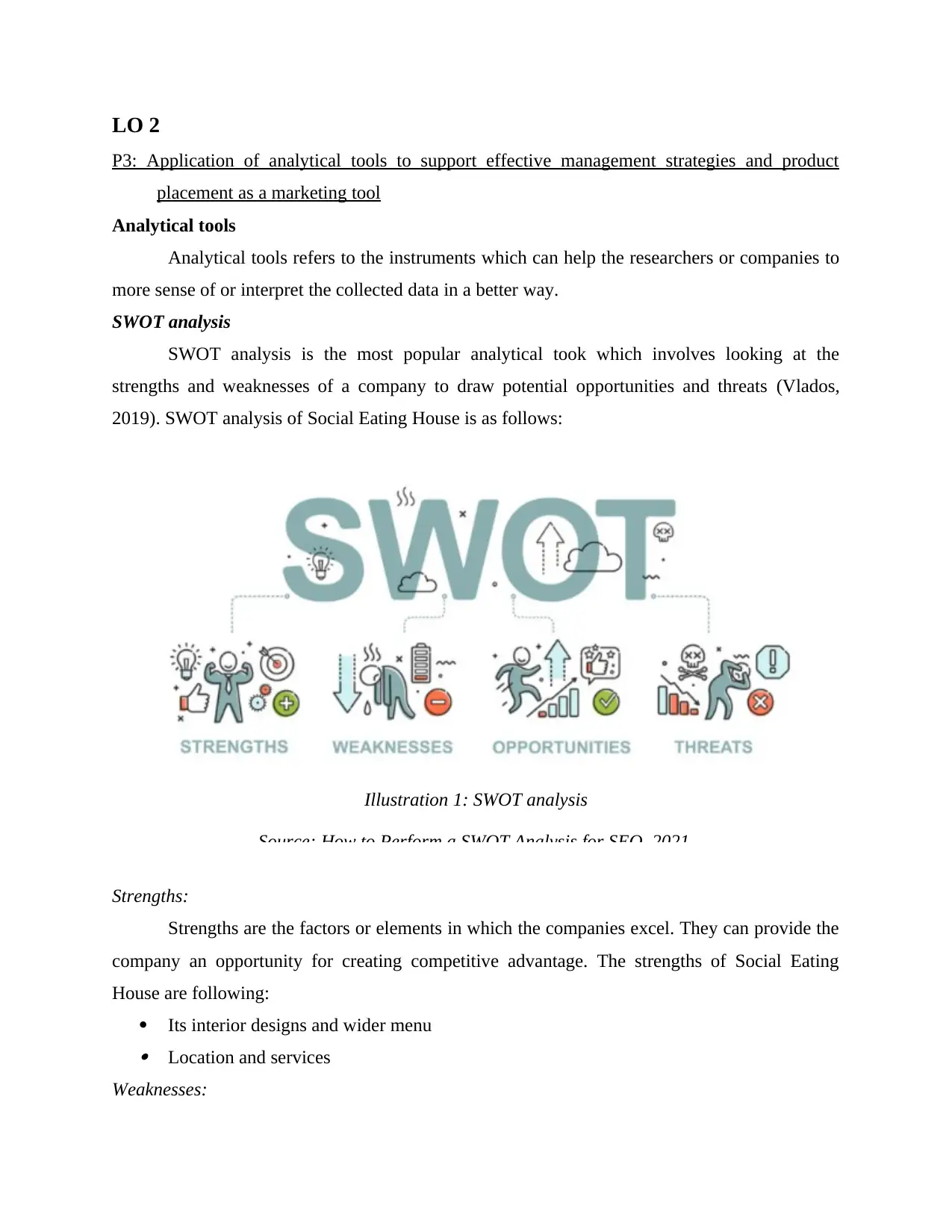
LO 2
P3: Application of analytical tools to support effective management strategies and product
placement as a marketing tool
Analytical tools
Analytical tools refers to the instruments which can help the researchers or companies to
more sense of or interpret the collected data in a better way.
SWOT analysis
SWOT analysis is the most popular analytical took which involves looking at the
strengths and weaknesses of a company to draw potential opportunities and threats (Vlados,
2019). SWOT analysis of Social Eating House is as follows:
Strengths:
Strengths are the factors or elements in which the companies excel. They can provide the
company an opportunity for creating competitive advantage. The strengths of Social Eating
House are following:
Its interior designs and wider menu Location and services
Weaknesses:
Illustration 1: SWOT analysis
Source: How to Perform a SWOT Analysis for SEO, 2021.
P3: Application of analytical tools to support effective management strategies and product
placement as a marketing tool
Analytical tools
Analytical tools refers to the instruments which can help the researchers or companies to
more sense of or interpret the collected data in a better way.
SWOT analysis
SWOT analysis is the most popular analytical took which involves looking at the
strengths and weaknesses of a company to draw potential opportunities and threats (Vlados,
2019). SWOT analysis of Social Eating House is as follows:
Strengths:
Strengths are the factors or elements in which the companies excel. They can provide the
company an opportunity for creating competitive advantage. The strengths of Social Eating
House are following:
Its interior designs and wider menu Location and services
Weaknesses:
Illustration 1: SWOT analysis
Source: How to Perform a SWOT Analysis for SEO, 2021.
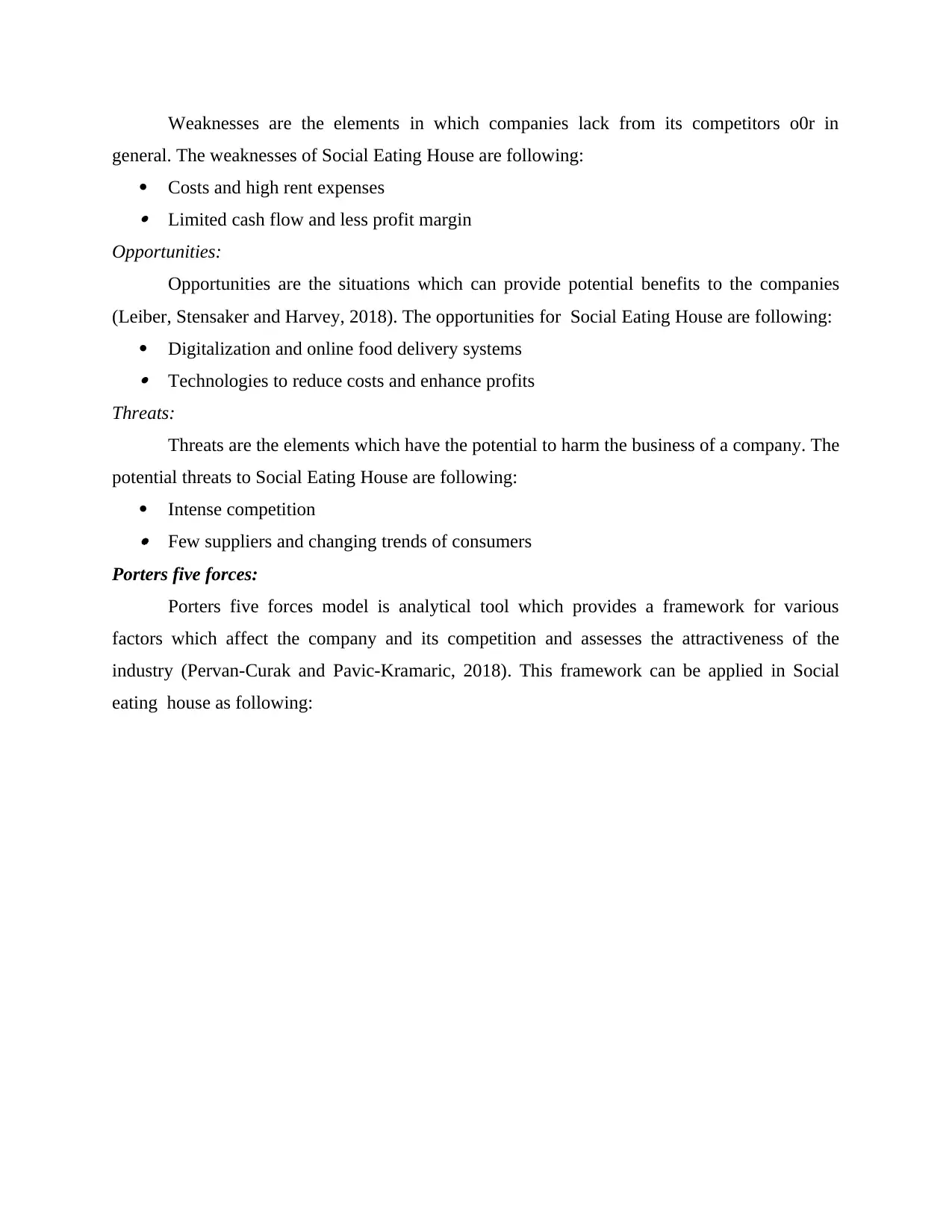
Weaknesses are the elements in which companies lack from its competitors o0r in
general. The weaknesses of Social Eating House are following:
Costs and high rent expenses Limited cash flow and less profit margin
Opportunities:
Opportunities are the situations which can provide potential benefits to the companies
(Leiber, Stensaker and Harvey, 2018). The opportunities for Social Eating House are following:
Digitalization and online food delivery systems Technologies to reduce costs and enhance profits
Threats:
Threats are the elements which have the potential to harm the business of a company. The
potential threats to Social Eating House are following:
Intense competition Few suppliers and changing trends of consumers
Porters five forces:
Porters five forces model is analytical tool which provides a framework for various
factors which affect the company and its competition and assesses the attractiveness of the
industry (Pervan-Curak and Pavic-Kramaric, 2018). This framework can be applied in Social
eating house as following:
general. The weaknesses of Social Eating House are following:
Costs and high rent expenses Limited cash flow and less profit margin
Opportunities:
Opportunities are the situations which can provide potential benefits to the companies
(Leiber, Stensaker and Harvey, 2018). The opportunities for Social Eating House are following:
Digitalization and online food delivery systems Technologies to reduce costs and enhance profits
Threats:
Threats are the elements which have the potential to harm the business of a company. The
potential threats to Social Eating House are following:
Intense competition Few suppliers and changing trends of consumers
Porters five forces:
Porters five forces model is analytical tool which provides a framework for various
factors which affect the company and its competition and assesses the attractiveness of the
industry (Pervan-Curak and Pavic-Kramaric, 2018). This framework can be applied in Social
eating house as following:
⊘ This is a preview!⊘
Do you want full access?
Subscribe today to unlock all pages.

Trusted by 1+ million students worldwide
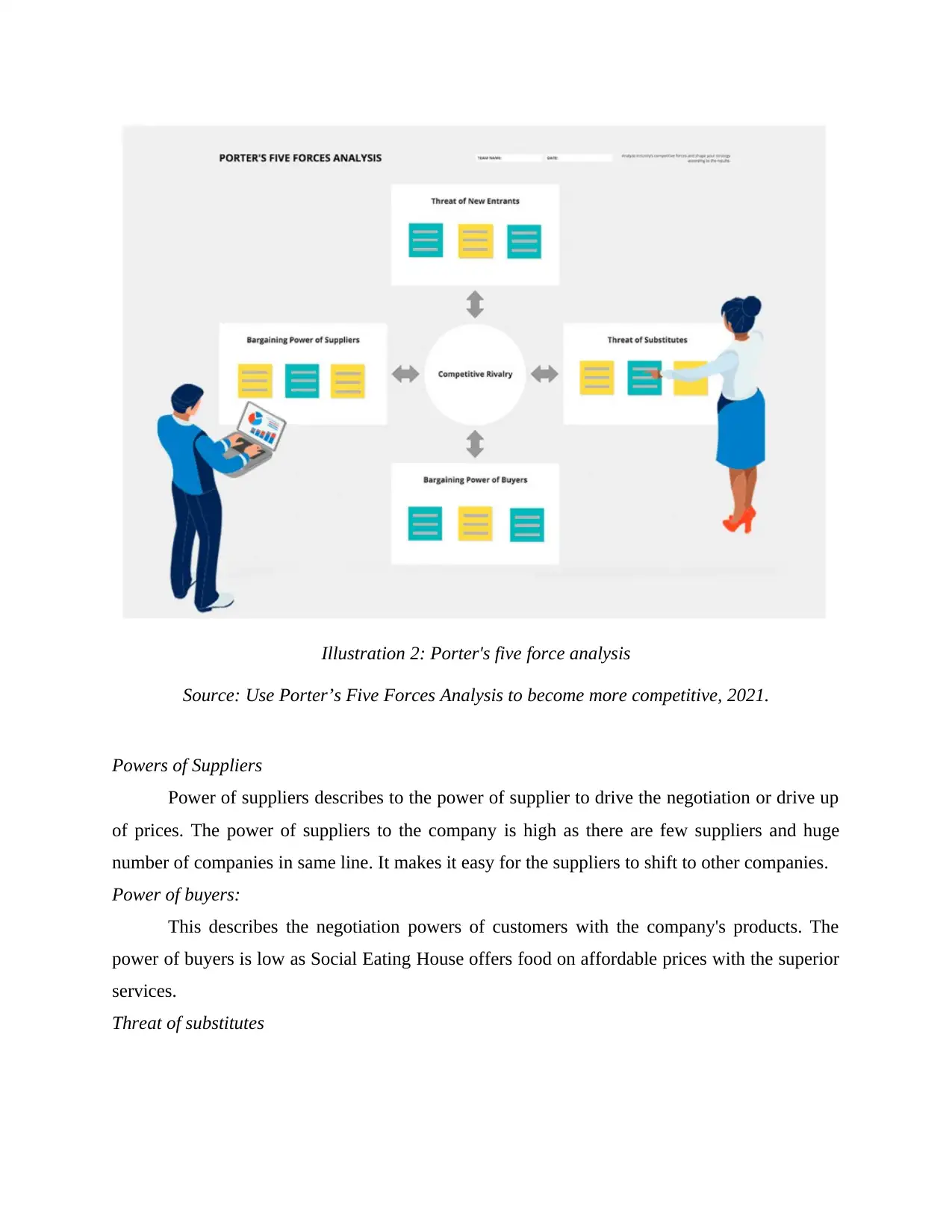
Powers of Suppliers
Power of suppliers describes to the power of supplier to drive the negotiation or drive up
of prices. The power of suppliers to the company is high as there are few suppliers and huge
number of companies in same line. It makes it easy for the suppliers to shift to other companies.
Power of buyers:
This describes the negotiation powers of customers with the company's products. The
power of buyers is low as Social Eating House offers food on affordable prices with the superior
services.
Threat of substitutes
Illustration 2: Porter's five force analysis
Source: Use Porter’s Five Forces Analysis to become more competitive, 2021.
Power of suppliers describes to the power of supplier to drive the negotiation or drive up
of prices. The power of suppliers to the company is high as there are few suppliers and huge
number of companies in same line. It makes it easy for the suppliers to shift to other companies.
Power of buyers:
This describes the negotiation powers of customers with the company's products. The
power of buyers is low as Social Eating House offers food on affordable prices with the superior
services.
Threat of substitutes
Illustration 2: Porter's five force analysis
Source: Use Porter’s Five Forces Analysis to become more competitive, 2021.
Paraphrase This Document
Need a fresh take? Get an instant paraphrase of this document with our AI Paraphraser
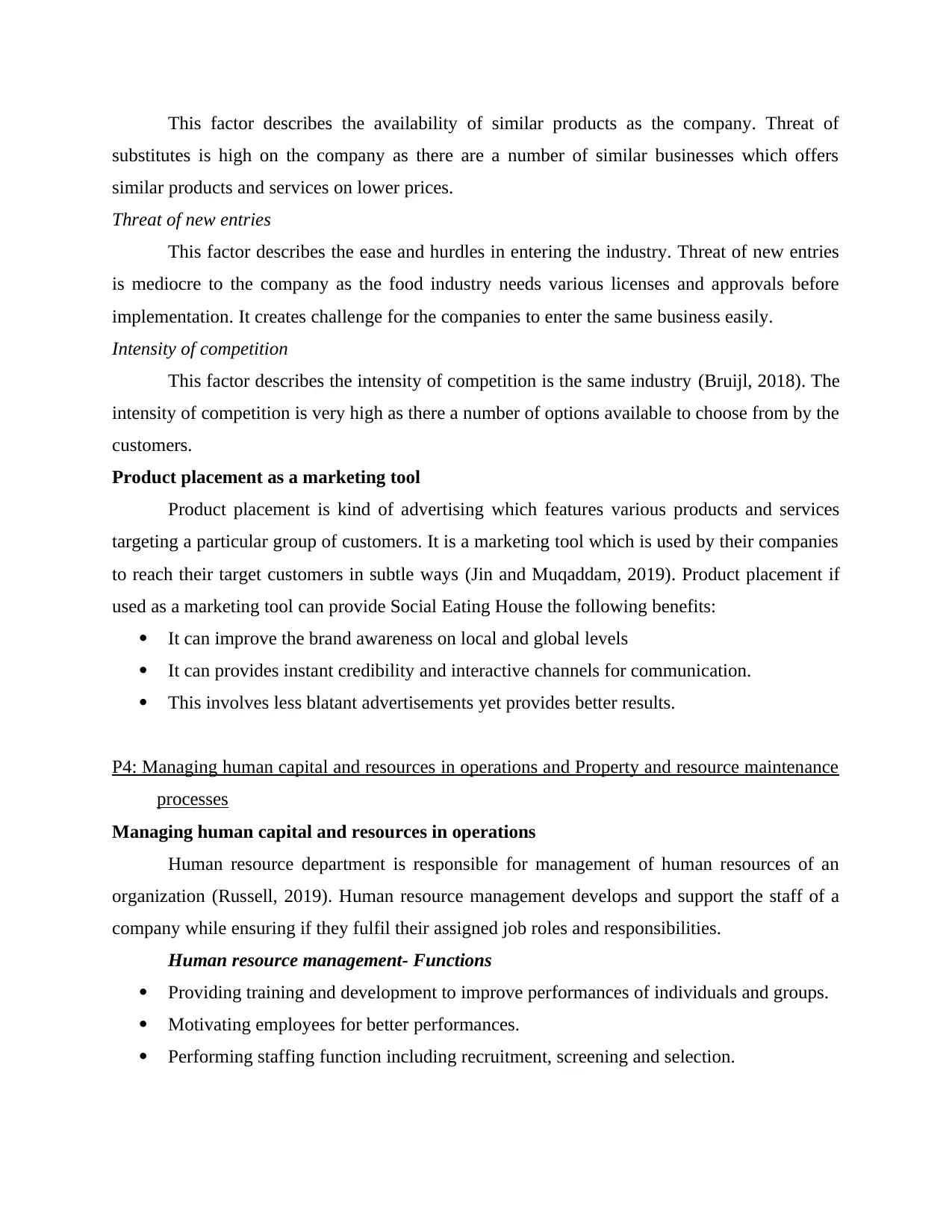
This factor describes the availability of similar products as the company. Threat of
substitutes is high on the company as there are a number of similar businesses which offers
similar products and services on lower prices.
Threat of new entries
This factor describes the ease and hurdles in entering the industry. Threat of new entries
is mediocre to the company as the food industry needs various licenses and approvals before
implementation. It creates challenge for the companies to enter the same business easily.
Intensity of competition
This factor describes the intensity of competition is the same industry (Bruijl, 2018). The
intensity of competition is very high as there a number of options available to choose from by the
customers.
Product placement as a marketing tool
Product placement is kind of advertising which features various products and services
targeting a particular group of customers. It is a marketing tool which is used by their companies
to reach their target customers in subtle ways (Jin and Muqaddam, 2019). Product placement if
used as a marketing tool can provide Social Eating House the following benefits:
It can improve the brand awareness on local and global levels
It can provides instant credibility and interactive channels for communication.
This involves less blatant advertisements yet provides better results.
P4: Managing human capital and resources in operations and Property and resource maintenance
processes
Managing human capital and resources in operations
Human resource department is responsible for management of human resources of an
organization (Russell, 2019). Human resource management develops and support the staff of a
company while ensuring if they fulfil their assigned job roles and responsibilities.
Human resource management- Functions
Providing training and development to improve performances of individuals and groups.
Motivating employees for better performances.
Performing staffing function including recruitment, screening and selection.
substitutes is high on the company as there are a number of similar businesses which offers
similar products and services on lower prices.
Threat of new entries
This factor describes the ease and hurdles in entering the industry. Threat of new entries
is mediocre to the company as the food industry needs various licenses and approvals before
implementation. It creates challenge for the companies to enter the same business easily.
Intensity of competition
This factor describes the intensity of competition is the same industry (Bruijl, 2018). The
intensity of competition is very high as there a number of options available to choose from by the
customers.
Product placement as a marketing tool
Product placement is kind of advertising which features various products and services
targeting a particular group of customers. It is a marketing tool which is used by their companies
to reach their target customers in subtle ways (Jin and Muqaddam, 2019). Product placement if
used as a marketing tool can provide Social Eating House the following benefits:
It can improve the brand awareness on local and global levels
It can provides instant credibility and interactive channels for communication.
This involves less blatant advertisements yet provides better results.
P4: Managing human capital and resources in operations and Property and resource maintenance
processes
Managing human capital and resources in operations
Human resource department is responsible for management of human resources of an
organization (Russell, 2019). Human resource management develops and support the staff of a
company while ensuring if they fulfil their assigned job roles and responsibilities.
Human resource management- Functions
Providing training and development to improve performances of individuals and groups.
Motivating employees for better performances.
Performing staffing function including recruitment, screening and selection.
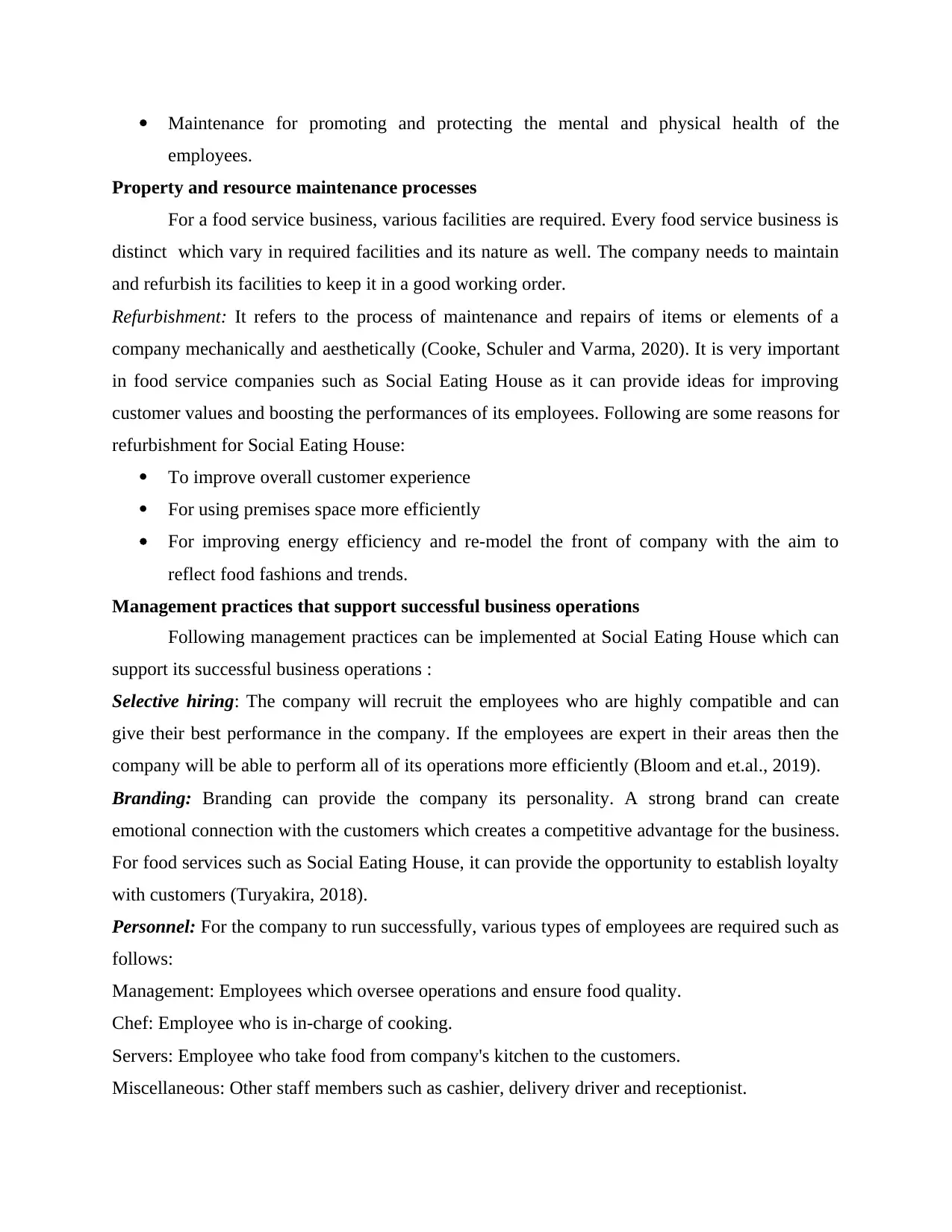
Maintenance for promoting and protecting the mental and physical health of the
employees.
Property and resource maintenance processes
For a food service business, various facilities are required. Every food service business is
distinct which vary in required facilities and its nature as well. The company needs to maintain
and refurbish its facilities to keep it in a good working order.
Refurbishment: It refers to the process of maintenance and repairs of items or elements of a
company mechanically and aesthetically (Cooke, Schuler and Varma, 2020). It is very important
in food service companies such as Social Eating House as it can provide ideas for improving
customer values and boosting the performances of its employees. Following are some reasons for
refurbishment for Social Eating House:
To improve overall customer experience
For using premises space more efficiently
For improving energy efficiency and re-model the front of company with the aim to
reflect food fashions and trends.
Management practices that support successful business operations
Following management practices can be implemented at Social Eating House which can
support its successful business operations :
Selective hiring: The company will recruit the employees who are highly compatible and can
give their best performance in the company. If the employees are expert in their areas then the
company will be able to perform all of its operations more efficiently (Bloom and et.al., 2019).
Branding: Branding can provide the company its personality. A strong brand can create
emotional connection with the customers which creates a competitive advantage for the business.
For food services such as Social Eating House, it can provide the opportunity to establish loyalty
with customers (Turyakira, 2018).
Personnel: For the company to run successfully, various types of employees are required such as
follows:
Management: Employees which oversee operations and ensure food quality.
Chef: Employee who is in-charge of cooking.
Servers: Employee who take food from company's kitchen to the customers.
Miscellaneous: Other staff members such as cashier, delivery driver and receptionist.
employees.
Property and resource maintenance processes
For a food service business, various facilities are required. Every food service business is
distinct which vary in required facilities and its nature as well. The company needs to maintain
and refurbish its facilities to keep it in a good working order.
Refurbishment: It refers to the process of maintenance and repairs of items or elements of a
company mechanically and aesthetically (Cooke, Schuler and Varma, 2020). It is very important
in food service companies such as Social Eating House as it can provide ideas for improving
customer values and boosting the performances of its employees. Following are some reasons for
refurbishment for Social Eating House:
To improve overall customer experience
For using premises space more efficiently
For improving energy efficiency and re-model the front of company with the aim to
reflect food fashions and trends.
Management practices that support successful business operations
Following management practices can be implemented at Social Eating House which can
support its successful business operations :
Selective hiring: The company will recruit the employees who are highly compatible and can
give their best performance in the company. If the employees are expert in their areas then the
company will be able to perform all of its operations more efficiently (Bloom and et.al., 2019).
Branding: Branding can provide the company its personality. A strong brand can create
emotional connection with the customers which creates a competitive advantage for the business.
For food services such as Social Eating House, it can provide the opportunity to establish loyalty
with customers (Turyakira, 2018).
Personnel: For the company to run successfully, various types of employees are required such as
follows:
Management: Employees which oversee operations and ensure food quality.
Chef: Employee who is in-charge of cooking.
Servers: Employee who take food from company's kitchen to the customers.
Miscellaneous: Other staff members such as cashier, delivery driver and receptionist.
⊘ This is a preview!⊘
Do you want full access?
Subscribe today to unlock all pages.

Trusted by 1+ million students worldwide
1 out of 24
Related Documents
Your All-in-One AI-Powered Toolkit for Academic Success.
+13062052269
info@desklib.com
Available 24*7 on WhatsApp / Email
![[object Object]](/_next/static/media/star-bottom.7253800d.svg)
Unlock your academic potential
Copyright © 2020–2026 A2Z Services. All Rights Reserved. Developed and managed by ZUCOL.


